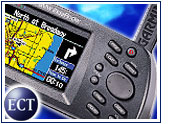
You are walking past a coffee shop one morning, your mobile phone beeps, and up pops a coupon for a free croissant. You are driving on the highway when your computer screen displays a message telling you that an accident has occurred 10 miles up the road, so you take an alternate route.
Zealous vendors have been talking about such applications for a few years, although these applications have been virtually nonexistent. For several reasons, the Global Positioning System (GPS) — the network that supports these applications — has been too expensive to spur deployment of such services.
Suppliers expect that to change, but the exact point in the future when GPS becomes pervasive and corporations and end users alike widely adopt the technology remains uncertain.
Secret Weapon
The U.S. Government designed the GPS system for use in defense operations, thinking that improving the military’s ability to monitor enemies’ and its own weapons and troop deployments would result in fewer casualties.
During the past two decades, the government has invested billions of dollars in satellite and computer technology so it can monitor movements on Earth. Currently, 28 satellites hovering about 11,000 miles above Earth collect information so GPS users can examine the location of trucks, cars and even individuals with remarkable precision.
In addition to military applications, the government envisioned widespread commercial use of the technology, but GPS has garnered acceptance only in select markets, such as commercial transportation.
“It’s very easy for long-haul or short-haul trucking companies to cost-justify GPS deployment,” Frank Viquez, a research analyst at market research firm Allied Business Intelligence, told TechNewsWorld. “These services help them to make sure that their trucks carry as much freight as possible.”
In addition to commercial transportation adoption, a few other vertical applications have emerged. GPS positioning is so precise, for example, that farmers use it when spraying and seeding their fields, and construction companies rely on it to help operators maneuver complex equipment, such as cranes and bulldozers.
Keeping the Roads Safe
In the consumer space, GPS guides the OnStar system used in General Motors automobiles. The system mainly aids drivers in reaching their destinations, but also can track stolen vehicles, notify consumers when their autos are in need of repairs, and help police and rescue crews pinpoint accident locations.
Approximately half of worldwide GPS revenue of about US$1.9 billion stems from such applications, according to Allied Business Intelligence. However, vendors are not content with niche acceptance and want the large revenues that come from mass-market adoption.
“GPS acceptance in the consumer market has certainly evolved a lot slower in the United States than what carriers expected a few years ago,” Ira Brodsky, principal at Datacomm Research, told TechNewsWorld.
Niche markets typically lead to expensive equipment. “If you are thinking about putting in a GPS system, then you are looking at about an investment of about $1,000,” ABI’s Viquez told TechNewsWorld. Such high prices have prevented carriers from giving away the needed equipment and recouping their investment in monthly service fees.
Congress Lends a Hand
GPS systems have relied on proprietary mapping techniques, so equipment vendors have not been able to drive down costs by using common components. The proprietary architectures force third-party application developers to tailor their products to different systems, which drives up their costs and slows down new application delivery.
In addition to high costs, there have been some practical problems associated with rolling out the services. “Among business professionals, there hasn’t been significant demand for GPS services because once you walk into an office building, you can’t receive a GPS signal,” noted Brodsky.
Yet changes have been taking place. The U.S. Congress has decreed that mobile phone systems be able to pinpoint the location of incoming 911 calls. As a result, companies such as Sprint and Verizon have begun delivering phones that include GPS capabilities.
Also, the industry has been coalescing around standard chipsets that are driving down manufacturing costs, according to Will Strauss, principal at market research firm Forward Concepts. And suppliers have developed ways to locate individuals inside office buildings: New hybrid systems pass caller location information from the GPS to the telecommunications network.
Consumers Balk at High Prices
As vendors clear some technological and cost hurdles, questions have begun to arise about what types of services companies and consumers actually desire. At this stage, corporate applications are not well defined, but carriers expect consumers to be interested in information, such as the location of the nearest restaurant or the exact distance from a golf ball to the cup.
Vendors remain uncertain how much consumers will pay for such applications. “The vendors talk about adding an extra $20 to $30 to the monthly phone bill,” Brodsky told TechNewsWorld. “I think that will be too high for most consumers, who would feel comfortable with a negligible cost, say $10 or less a month.”
That deduction seems to mirror the moderate success OnStar has had in rolling out its technology to the automotive industry. Typically, automobile manufacturers either bundle the service with a new car purchase or offer it at a discounted rate of less than $100 for the first year. After that, the consumer typically must pay a higher monthly fee, which often translates to a few hundred dollars annually. This rate issue is one reason why GPS renewals in the automotive industry have been disappointing: less than 50 percent.
During the next 12 to 18 months, carriers are expected to experiment with new GPS services and pricing models, from bundling the services into monthly bills to pay-as-you-go options. “Certain services and billing models will gain acceptance, but at this stage, no one — not even the carriers — knows what they will be, how they will be packaged or when usage will take hold,” concluded Brodsky.





















































